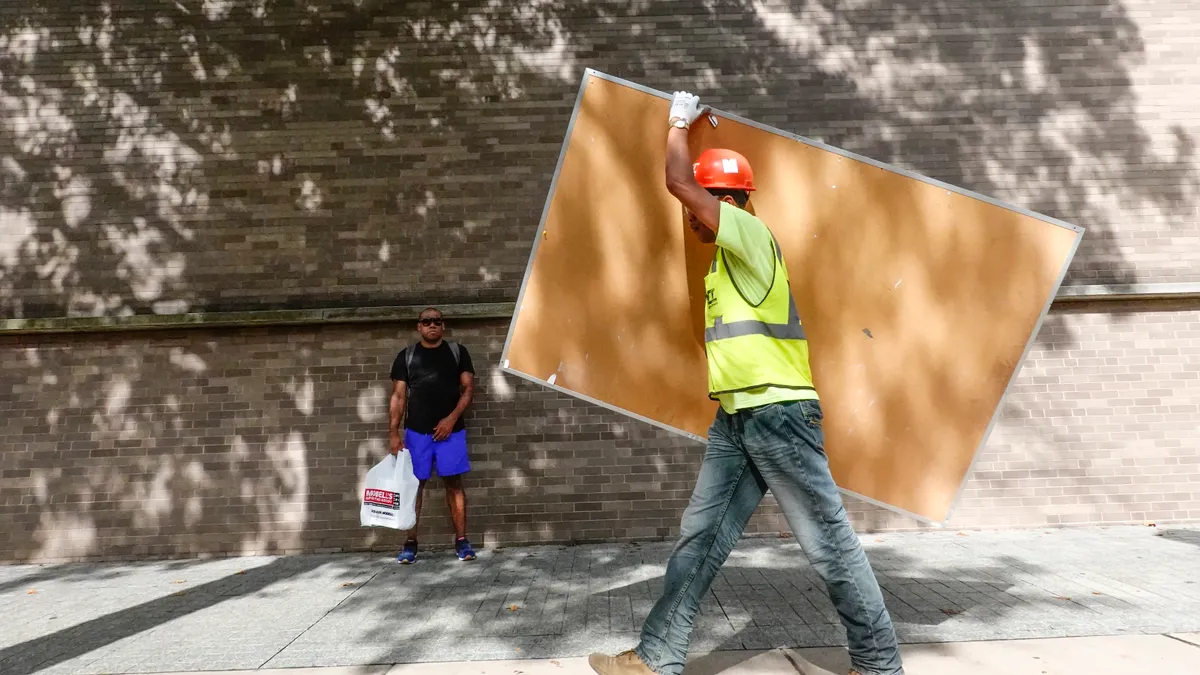Some things never change, and that can be said for almost all of the entries on OSHA's 2018 top 10 Most Frequently Cited Violations list. In fact, eight of the most violated standards by all industries were on last year's list, and the top four — fall protection, hazard communication, scaffolds and respiratory protection — have been on the list since the agency started compiling it in 2015.
The list covers violations that OSHA issued during fiscal year Oct. 1, 2017 through Sept. 30, 2018, but the data is preliminary. Here is a breakdown of the total number of violations per standard (includes all industries) as well as details about each standard.
1. Fall protection — general requirements
7,270 violations
OSHA statistics have shown that falls are the leading cause of U.S. construction site deaths.
This standard covers construction and all other industries, and includes general regulations like the requirement that employers provide fall protection systems and protections for employees working near or walking on surfaces from which they can fall six feet or more, including roofs, excavations and hoist areas. The standard also includes protections from falling objects.
Included in the citations for fall protection was one issued to Kasper Roofing & Construction, based in Windermere, Florida, in April. OSHA cited Kasper after one of its employees fell to his death on a jobsite near Orlando. The agency proposed a fine of $134,000.
2. Hazard communication
4,552 violations
A major portion of this standard deals with identifying toxic or hazardous chemicals and substances, making sure they're labeled appropriately, maintaining safety data sheets on-site and training employees on their potential dangers.
While hazardous chemicals stand out as an obvious risk, there are also materials that are under the radar. For example, the coating on some steel is considered hazardous, as is the dust created by sanding drywall mud.
However, manufacturers and suppliers have safety data sheets on how to handle hazardous materials readily available for contractors.
Just this month, OSHA cited a Texas drilling company, Legend Directional Services, for failing to train their employees on the hazards of flammable chemicals, among other violations, and proposed a total fine of $28,455.
3. Scaffolds — general requirements
3,336 violations
The sight of scaffolding hugging the side of a building under construction is one of the most common images associated with an active jobsite, and this standard speaks to safe scaffolding design, installation and use.
OSHA prescribes safety regulations regarding scaffolding systems, including suspension, ladder jack, top plate bracket, roof bracket, outrigger and pump jack scaffolds. The standard also includes fall protection and fall arrest system requirements for those working on scaffolding at 10 feet above a lower level.
In June, OSHA proposed fines of $120,320 and issued Wisconsin roofing contractor Hector Hernandez of Town City Construction violation citations related to fall protection and other safety hazards on two jobsites. The violations included failure to train employees about fall hazards and not using the required ladder jack scaffold components.
4. Respiratory protection
3,118 violations
Contractors and all employers have a responsibility to protect the respiratory health of their employees, and this standard requires them to provide workers with the necessary respirators to protect them from air that is contaminated with harmful dust fog, fumes, mist, gases, smoke, sprays or vapors. This standard also allows employers to institute engineering controls like ventilation or the use of enclosures or confinement of operations.
In addition, the standard requires employers to develop and institute a written respiratory protection program, with site-specific equipment and procedures provided to employees.
OSHA issued citations related to respirator use to Manafort Bros. in November 2017 after the agency determined that the contractor did not take adequate measures to protect its employees while they were working on a mercury boiler on a project in Concord, New Hampshire. Manafort has contested the citations as well as the proposed fine of $329,548.
5. Lockout/tagout
2,944 violations
This general industry standard technically excludes the construction industry but would apply should contractors do electrical work on their premises.
This OSHA standard tries to reduce the danger of working around or on equipment that could suddenly restart while performing maintenance or repairs by using lockout or tagout devices. Examples are devices that isolate breakers; prevent fluid or gas valves from being opened; lock out electrical plugs, cords and air hose connectors; or prevent flipping of an "on" switch.
A tag identifies the person who placed the lockout device on the piece of equipment and that person is the only one who can remove the lock.
6. Ladders
2,812 violations
Ladder safety goes hand-in-hand with fall protection. This standard covers mandatory load-bearing capabilities — typically from a little more than three times to four times the maximum intended load — rung and step spacing, skid resistance, clearance and safety devices.
When OSHA cited JK Excavation & Utilities after one of its employees died in a 16-foot-trench collapse, one of the citations included improper use of ladders for entry and exit. The agency fined the contractor $202,201 but it was negotiated down to $151,650 as part of an informal settlement.
7. Powered industrial trucks
2,294 violations
This standard covers the use of equipment like platform lift trucks, motorized hand trucks, fork trucks and other trucks powered by electric motors or internal combustion engines. It sets requirements for design as well, in addition to fire hazard safeguards, required markings and where they may be used.
8. Fall protection — training requirements
1,982 violations
Where there is a fall protection violation, there is often a failure on the part of the contractor to provide adequate fall protection training. In order to meet the requirements of this standard, contractors must provide training to employees who could be exposed to fall hazards in the performance of their duties.
A trained person must conduct the sessions, topics for which include what kind of hazards workers might encounter; how to install, use and inspect fall protection systems; limitations of fall protection equipment; proper storage and maintenance of equipment; and the role each employee plays in the company's fall protection plan.
When OSHA cited Kansas contractor Jose Barrientos in May, one of the violations that earned Barrientos a $191,071 proposed fine was lack of fall hazard training for the company's workers.
9. Machine guarding
1,972 violations
This standard requires contractors to protect equipment and tool operators from injuries that can be caused by sparks, flying chips, rotating parts and other dangers. Accepted controls include barrier guards, two-hand tripping devices, electronic safety devices and anchoring to keep fixed tools or equipment from "walking" during operations.
10. Personal protective and lifesaving equipment — eye and face protection
1,536 violations
Construction employers are required to provide hazard-specific eye and face protective wear and make sure workers use them to be protected from jobsite dangers like flying particles or other debris, molten metal, chemicals, acids, caustic liquids, gases and vapors, and light radiation.
The shade number of eyewear for welders must also be task-appropriate. For example, soldering requires shade No. 2, but shielded metal arc welding requires the higher-density shade No. 12.
When OSHA cited Lanford Bros. Co. in Marion, Virginia, in August under the revised silica standard, the agency also issued the company two serious violations for improper eye or face protection. Proposed fines against the company totaled $304,130, although the citations and fines are under contest.




















